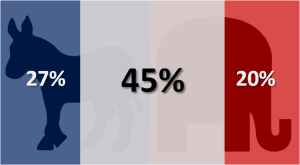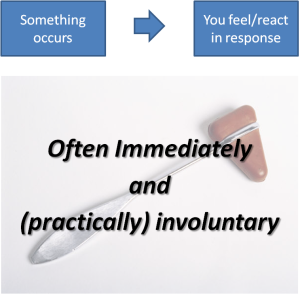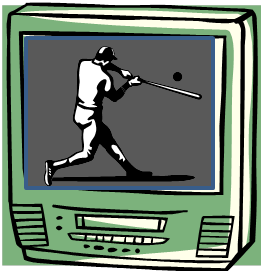The focus of my blog, and my hope, is to get more people engaging in thoughtful, civil discourse. I sometimes wonder if I am just too far out there in that hope.
One of the challenges is that it takes effort to engage thoroughly and thoughtfully. Going by our gut is so much easier. And as I have stated in an earlier post, this is further undermined by the common practice of reacting instead of responding.
 A lot of the “news” today is not about conveying facts for us to evaluate. It is about playing to our emotions. A week or so ago, I came across the item below (excerpted from an article (here) which talks about impressionability (emphasis mine):
A lot of the “news” today is not about conveying facts for us to evaluate. It is about playing to our emotions. A week or so ago, I came across the item below (excerpted from an article (here) which talks about impressionability (emphasis mine):
“Voters are basically lazy,” one Nixon media adviser wrote. “Reason requires a high degree of discipline, of concentration; impression is easier. Reason pushes the viewer back, it assaults him, it demands that he agree or disagree; impression can envelop him, invite him in, without making an intellectual demand…. When we argue with him, we… seek to engage his intellect…. The emotions are more easily roused, closer to the surface, more malleable….” Nixon’s people hired advertising executive Harry Treleaven, who believed the new medium of television had changed the nature of politics. For him, politicians were no longer policy wonks; they were actors with a narrative.
Under Treleaven, Nixon’s people ignored policy positions and instead used television to create a candidate with a simple message: America was on the brink of disaster, and only Nixon could save it. They hired a brilliant young photographer to put together a series of television ads from stock photographs strung together to create a sense of doom; at the end a voice intoned “Nixon” over an iconic image of the nation. At the end of every ad ran the words: “Vote like your whole world depended on it.”
While the source article is tilted at (against) a particular political party, the cornerstone concept I am pointing to goes well beyond politics or parties. I do not want to make this a partisan thing.
Further on, in the same article, they show a path from this earlier thinking, to the philosophy and M.O. of one news organization today – though others have adopted this strategy too. If you measure success as the number of subscribers or followers, as is normal for the media, then this is a successful formula. If you measure it on how accurately informed the viewership is, then it is far from successful. Much of that viewership, regardless of the source channel, is misinformed (and misled) through, either, cherry-picked subsets of data, opinion substituting for fact, or with emotionally appealing falsehoods. And through repetition the viewership begins to accept the impressions cast by those “news sources” as truths. Using the definition right out of a dictionary, this should be labeled propaganda (not news).
We have become accustomed to the abbreviated form. It is all around us. Catchy advertising and campaign slogans that stick with us. One-hundred and forty byte “statements” in the form of tweets (yes, I tweet too.) Text messages, with oh so many abbreviations, and sometimes in place of more expansive, face-to-face conversations. When we actually pick up a newspaper or magazine, how often do we read the highlights, the call-outs, just the captions under the pictures, and not the full articles? We want things quick and easy. I confess, too often, and too impatiently, I ask people to “net it out” for me.
A joke made by Woody Allen years ago – fits the situation today:
“I took a speed reading course and read War and Peace in twenty minutes. It involves Russia.”
I spent a handful of years in marketing and learned about creating “tag lines” (short hand for our key message) and “elevator pitches” (intended to get your fundamental point across as concisely as possible), and the general art of spin. A former colleague used the phrase “fiction with conviction” as both a critique of the discipline of marketing and a description – ironically a sound-bite in itself. When building marketing material, we used a method where you started by defining the one thing you really want the audience to take away, and build out from there. You build out supporting arguments – but not too many. You add specific images to reinforce. You tighten it up, keep it brief, because you want to keep their attention. You hope they remember much of what you put together. But you count on them retaining the core thought or position. Trying to convey some facts, but at a minimum, focusing on leaving an impression. I understand the power of this method.
Distorted presentation with emotional appeal

It is not just the main-stream media or marketers either. The pervasiveness of the internet, ready access to gadgets to take pictures and video, simple editing tools, allow almost anyone to “publish” content. My blog is certainly an example. Because of this, lots of misinformation is widely available. And “spun” misinformation gets attention and sometimes a significant following.
Just last week, my son sent me a link to a post he said “proved his point” about negative repercussions in the faith community from the recent same-sex-marriage decision by the Supreme Court. The post was about a clergyman being sent to prison for not performing a same-sex wedding. I told him I would look at it later, and asked him if he knew if it was a credible source. He had assumed it was legitimate. I discovered it was a hoax. I shared those findings with him and we talked about the implications of folks reacting without verifying.
 Then shortly after that, a highly misrepresentative, heavily edited 8 minute video, surfaced – slamming Planned Parenthood. It gained a lot of attention for its provocative headline and premise. It was a very effective in its’ deception. Because of scrutiny and public pressure, the whole 100 plus minutes of raw video were released. From inspection of this raw footage, by multiple groups, it was determined that many of the clips in the edited version were used wholly out of context, and others portions of the edited video actually represented the complete opposite of the truth, of what was said and meant.
Then shortly after that, a highly misrepresentative, heavily edited 8 minute video, surfaced – slamming Planned Parenthood. It gained a lot of attention for its provocative headline and premise. It was a very effective in its’ deception. Because of scrutiny and public pressure, the whole 100 plus minutes of raw video were released. From inspection of this raw footage, by multiple groups, it was determined that many of the clips in the edited version were used wholly out of context, and others portions of the edited video actually represented the complete opposite of the truth, of what was said and meant.
Yes we (may) have busy lives and it is convenient to get the synopsis. But have we become too accustomed to this shorthand? I think we have. Can’t we set aside a little time to look a little deeper into important matters? I think we can. I hope we do.

Issue by issue
Stealing a comment I heard on a radio show, when asked which way do I lean (politically), I respond “on what issue?” (yes, I get the irony of echoing the external source). FYI – I have been registered as an independent my entire voting life.
I think the increasing feeling of polarization in our country, is based on the false premise that we need to subscribe to, to lean, right or left, to choose a side. There seems less tolerance for agreeing-to-disagree. I see this as just another form of convenience, simplification. We can quickly slot another into the group of those we like (us) or those we dislike (them) based on how they lean. And, we probably find it easier to slot ourselves into a group, than to define our views issue-by-issue.

Many polls , of late, suggest that an increasing portion of Americans are identifying as independents (rather than Democrat or Republican). I find that encouraging. I hope some portion of that is attributable to folks wanting to exercise personal judgment per issue, rather than voting the party line.
Conclusion
Am I too far out there in my expressed hope? You’ll have to decide for yourself. Since I am an optimist, and I believe we can be rational creatures, I will continue to post. I will encourage people to look beyond the sound-bite, and not to be too impressionable.
I will encourage people to put in some effort, to engage others, to verify, to adjust and expand what they know, and to decide for themselves.
 Finally, if you have read all the way through this post to this sentence, it shows you exerted effort and expended time trying to understand someone else’s point of view. Encouraging – Thank you for doing so.
Finally, if you have read all the way through this post to this sentence, it shows you exerted effort and expended time trying to understand someone else’s point of view. Encouraging – Thank you for doing so.























